
Detail of Gamble House in Pasadena

Detail of Gamble House in Pasadena
In February 2008 the BCMA (Broad Contemporary Art Museum) opened next door to the LACMA (Los Angeles Country Museum of Art). Both museums share the same campus, which is still undergoing a major overhaul.
Apart from yet another abbreviation the BCMA brought not only a rather interesting collection of modern art to the city, but also an installation outside on the piazza between the two museums: “Urban Light” by Chris Burden.
This installation, consisting of 202 street lamps, most of them actually originating from Los Angeles, is one of my favorite pieces. There are new aspects from each and every angle, light and shadow paint pictures of their own, surrounding buildings (even those not connected to the museum) come into play for new and surprising compositions.


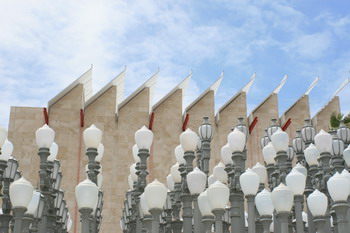
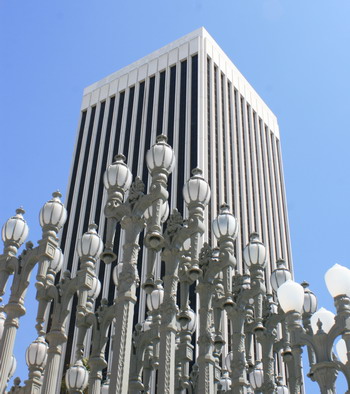


And yes, they do light up at night. One of these days I’ll have to go down to Wilshire on a balmy summer night for a new series of photos.
Down by the river everybody is busy hatching the new families. Some black-necked stilts were quite fast this year; their tiny little fluff balls are already out and about. As every year the parent birds are on high alert: Anything larger than a stilt is a potential danger to the chicks.
What do black-necked stilts (being rather small and fragile birds) do to protect their young as long as they can’t fly? As soon as the parent birds see anything dangerous approaching, they start to lure the assumed predator away.
Hey, I am here. HERE!
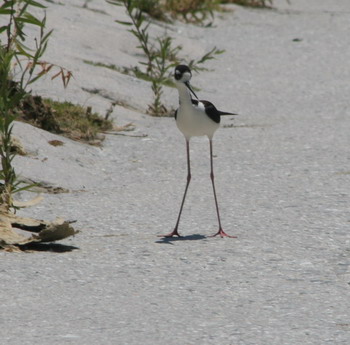
Look, something is wrong with me.
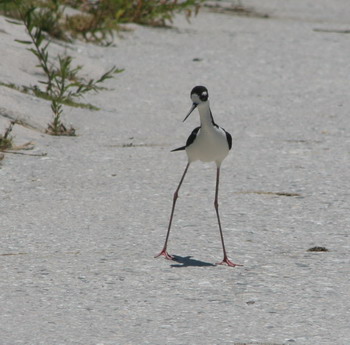
I can’t fly.
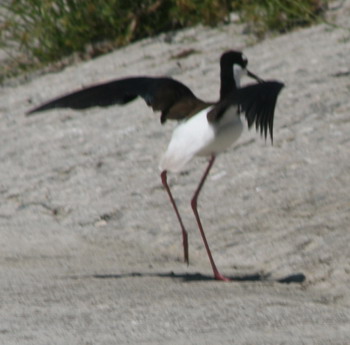
My legs are giving up.
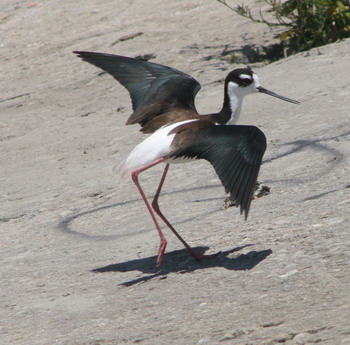
I’m done – broken wing, can’t run any more.
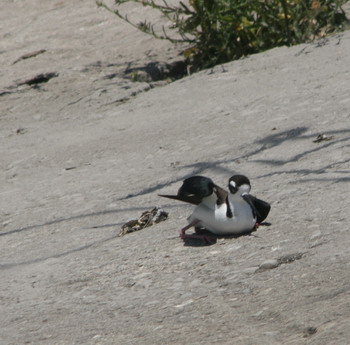
If the assumed predator now approaches the stilt, the bird musters up the last remnants of strength to fly again. Not very far, then it has to land again… that wing, you know… just a bit farther away from the spot where the little ones are hiding. This game continues until the stilt calculates that the distance to the hiding place is long enough – end of operation, miracle cure, the stilt flies away and returns to the spot where the chicks are safely tucked away, in a nice grass thicket or such. There the other parent joins in to give the “all clear” signal.
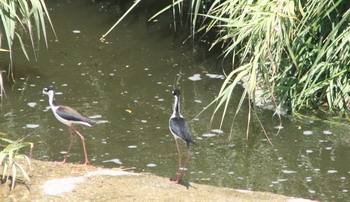
# 1 has left cover.

# 2 made it safely back too – hurray, the family is united again.


This parking space comes with your choice of carts.
This is not a California scrub oak in full bloom – this is a California scrub oak chosen by a Cup-of-Gold Vine (Solandra maxima) as a perfect climbing place.

The old Aztecs knew their Solandra quite well, albeit under the name ‘Tecomaxochitl’. They used the leaves to cook them up with cocoa; the resulting brew was then drunk as a love potion. I can just imagine the novice in the kitchen listening to Granny mumbling: “Be careful, dear, don’t give him too much of it – his body will dry out and he will die of too vigorous lovemaking.” Hmm… what a way to go.
Actually, the members of the Solandra family are an interesting bunch – they range from the Deadly Nightshade to the potatoes, including tomatoes, eggplant, paprika, chili peppers and tobacco.
And yes, the flowers and leaves of the potato plant are quite toxic, too, as the poor farmers in Germany learned when Frederick the Great (1712 – 1786) decreed that they had to plant this newfangled crop on their fields. Frederick needed food for his people, and even more so for his army – plenty of food, and cheap to boot. The potato was perfect. Unfortunately somehow nobody explained to the farmers which part of the plant was edible, so they cooked the green parts. Bon appetit – not. Once the initial confusion about the edible parts of these new crops was sorted out, the potato thrived and the people with it.
Actually, I met both members of the family in one day on Catalina Island: The strikingly beautiful bloom (diameter 4 inches) in the morning in the Botanical Garden, the rather more humble but tasty potato in the evening on my dinner plate. I enjoyed both very much.
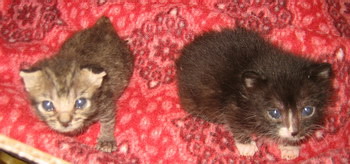
According to the Los Angeles Animal Services the city is populated at any time by approximately 26,000 – 48,000 stray dogs and 3 million feral cats.
In 2006 alone 46,000 animals found their way into the Los Angeles shelters, where they are kept for 52 days plus 7 additional days in the hope that they will be adopted. In 2006 this hope did not come true for 28 percent of the dogs and 57 percent of the cats. They were euthanized.
Enter the private and non-profit organizations, who run no-kill shelters for strays and also rescue animals from the city shelters to find new homes for them. These places, like the city shelters, are constantly battling with overcrowding and under funding. Most of them could not survive at all, where it not for volunteers giving their time (and money) to keep the safe havens for dogs and cats alive and operating.
The two tiny critters in the photo are foundlings, delivered to the Sante D’or Foundation on Sunset. There they will be available for adoption, together with their feline friends, rabbits and sometimes dogs, also looking for new homes.
Open here I flung the shutter, when, with many a flirt and flutter,
In there stepped a stately raven of the saintly days of yore.
Not the least obeisance made he; not a minute stopped or stayed he;
But, with mien of lord or lady, perched above my chamber door –
Perched upon a bust of Pallas just above my chamber door –
Perched, and sat, and nothing more.
Edgar Allan Poe ‘The Raven” 1845

Perched he was, together with his raven feathered mistress, high above me on top of the Wrigley Memorial on Catalina Island.
Ravens mate for life, but comes mating season the male has to bring the female presents of twigs and branches to repair last year’s nest. These two were apparently in the midst of preparing to raise a new family, because that was how I discovered them – the male came flying in with a particularly nice small branch. Once he sat on the ledge I noticed that it was indeed a raven; when sitting still their long throat feathers flutter in the wind, which makes these birds easily distinguishable from crows.
After some arranging of the new addition to the abode, high up on the memorial, the male raven took off again; maybe Madame was not yet satisfied.
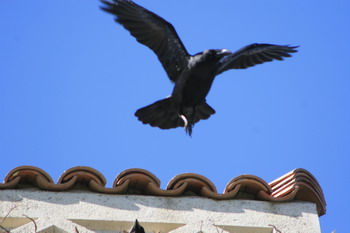
Apparently the time of perching and sitting and saying nothing more is still a way off for this particular member of the species; his mate seems to keep him busy.
An old Hopi legend I always liked is the one about the underground cities built by the lizard people along the Pacific Coast. Apparently those cities were constructed after a catastrophic meteor shower destroyed large areas and much of the population at around 3,000 BC. The lizard people not only seemed to be quite adapt at building subterranean cities; according to the legend they also possessed the first history books, detailing the history of the Earth since creation. How much they valued those books can be assumed from the fact that they were etched on golden tablets.
Such precious materials are no longer en vogue for books, but the Los Angeles Central Library sits – if one can believe the Hopi legend – on top of the site of one of those ancient cities, which incidentally was built in the form of a lizard. A quirky humor that lot had.
Is it sheer coincidence that some gold tones went into the decoration of the roof of the library?

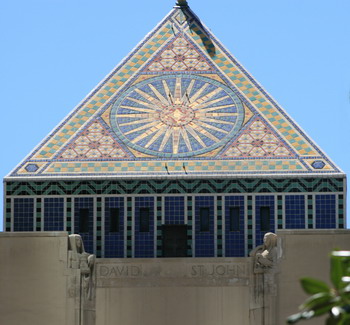
Maybe there is no connection – but what a wonderful thought that there might be one.
Coming out of the scrum, going for it.

Living in the city we are not starved for the sight of flowers. Actually, due to the mild climate (in Winter) and diligent watering (during the remainder of the year) one sees blooming plants and flowers the year around.

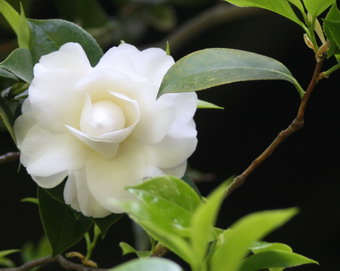
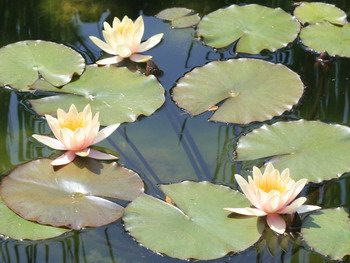
The story in regions with less water is completely different. In the desert, on the hills and at the foot of the mountains the wildflowers bloom only once a year, in Spring; but then otherwise brown and barren looking landscapes are transformed into areas covered with an abundance of flowers, ranging from the quietly pleasant to the spectacular. In fact, the deeper one drives into the desert, the more flamboyant the display becomes.
Not in the desert, but in the San Gabriel Mountains the view is this:
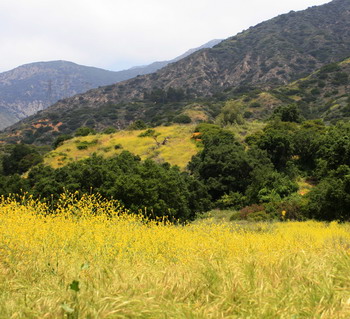
… for about three weeks.